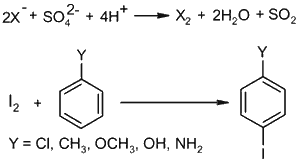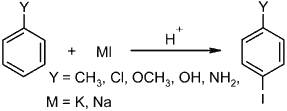Abstract
The reaction of electron-rich arenes with alkali metal iodides such as sodium and potassium iodides in the presence of conc. H2SO4 gives p-iodoarenes in high yields.
Introduction
Iodination of organic compounds and the chemistry of organic iodides are of interest as major chemical fields. Their industrial application is wide1. Iodination is one of the classical reactions of aromatic compounds and has been thoroughly investigated for both its theoretical and synthetic value. The iodination reactions of aromatic structures have generated a wealth of physico-organic data that define the structure?reactivity relationships and the steric and electronic factors that control this system2. Aromatic iodo compounds are useful for the preparation of organometallic reagents and some are potential intermediates for the synthesis of pharmaceutical and bioactive materials. They are also useful in metal catalysed coupling reactions which are widely applied in the preparation of complex molecules3.
Since the iodine molecule is the least reactive among the halogens toward an electrophilic substitution process, most of the synthetic effort has been placed in converting molecular iodine into a more active species4. Aromatic compounds iodinated can be generally by iodine only in the presence of a Lewis acid, a hydrogen iodide trap, or most commonly in the presence of an oxidizing agent.5
The reagents reported for iodination of aromatic compounds include use of N-iodosuccinimide (NIS),6 I2/Ag2SO4,7 I2/Cr2O3,8 I2/Pb(OAc)2,9 I2/TlOAc,10 I2/KI/Hg(OAc)2,11 NaOCl/NaI in aqueous alcohol medium,12 NaI/chloramine-T in methanol,13 and KI/HIO4 in H2SO414. Most of these reagents are complex, costly or involve toxic heavy metal catalysts with potential environmental problems due to the generation of hazardous waste. In this paper, we wish to report an efficient, new environmentally benign procedure for aromatic iodination.
Scheme 2

Scheme 1

Table 1.
Reaction of substituted arenes with alkali metal
iodides in the presence of conc. H2SO4 at 60?C.
Ex. |
Substrate |
Alkali Iodide |
Product |
Yield |
| 1 | Chloro- benzene | NaI | p-Chloro- iodobenzene |
84% |
| 2 | Chloro- benzene | KI | p-Chloro- iodobenzene |
87% |
| 3 | Toluene | NaI | p-Iodotoluene |
76% |
| 4 | Toluene | KI | p-Iodotoluene |
78% |
| 5 | Anisole | NaI | i) p-Iodoanisole |
59% |
ii) p-Iodophenol |
19% |
|||
| 6 | Anisole | KI | i) p-Iodoanisole |
67% |
ii) p-Iodophenol |
18% |
|||
| 7 | Phenol | NaI | p-Iodophenol |
81% |
| 8 | Phenol | KI | p-Iodophenol |
79% |
| 9 | Aniline | NaI | p-Iodoaniline |
80% |
10 | Aniline | KI | p-Iodoaniline |
82% |
11 | o-Cresol | NaI | 4-Iodo- 2-methylphenol |
75% |
12 | o-Cresol | KI | 4-Iodo- 2-methylphenol |
77% |
13 | Naphthalene | NaI | 1-Iodonaphthalene |
74% |
14 | Naphthalene | KI | 1-Iodonaphthalene |
75% |
15 | 2-Naphthol | NaI | 1-Iodo-2-naphthol |
86% |
16 | 2-Naphthol | KI | 1-Iodo-2-naphthol |
83% |
Owing to the various synthetic utilities of aromatic halo compounds, an attempt has been made in our laboratory to synthesize p-haloarenes from tetraalkylammonium halides in the presence of conc. H2SO4 in high yields15. To extend this reaction, we believe that alkali metal iodides can serve as iodinating agents. We carried out the reaction of aromatic hydrocarbons with alkali metal iodides such as sodium and potassium iodides in the presence of conc. H2SO4 and it was found that, iodination of arenes is possible with alkali metal iodides (Scheme 1).
The reaction of chlorobenzene and alkali metal iodides (NaI or KI) was carried out at different reaction temperatures (25?C, 40?C, 60?C, 80?C, 100?C, and 120?C) in the presence of conc. H2SO4. The reaction goes to completion within 1.5 hr at 60?C and p-chloroiodobenzene can be obtained in high yields.
To generalise the iodination reaction of arenes, different substituted aromatic hydrocarbons were chosen and the reaction was carried out under similar reaction conditions (Table 1). From the table it is clear that, except anisole, other arenes give iodination successfully in high yields.
Hot sulphuric acid is known to decompose sodium and potassium halides with evolution of halogen molecule as shown below16. Iodine thus formed reacts with arenes to give rise to iodoarenes as shown in Scheme 2 .
In summary, a novel approach to iodination of arenes using alkali metal iodides and conc. H2SO4 has been described.
Experimental
Nicolet 400D FT-IR spectrophotometer was used for IR spectral analysis and NMR spectra were recorded on a JEOL 90 FQ, Bruker AC 250 instrument. Yields refer to the isolated yields of the products.
Iodination of Arenes: General Procedure
Chlorobenzene (1.125 g, 10 mmol) and sodium iodide (3.0 g, 20 mmol) were added to conc. H2SO4 (1.96 g, 20 mmol) and then heated at 60?C. The reaction was monitored by TLC (light petroleum). After completion of the reaction (1.5 hr), water (10 mL) was added and extracted with ether (3?10 mL). The combined ethereal extract was washed with saturated sodium bicarbonate solution, water, and dried over anhydrous sodium sulphate. Solvent was removed, the residue purified on silica gel using pentane to give p-chloroiodobenzene (1.72g, 90%), mp 54?C (lit.17 mp 56?C).